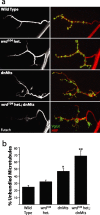The B' protein phosphatase 2A regulatory subunit well-rounded regulates synaptic growth and cytoskeletal stability at the Drosophila neuromuscular junction
- PMID: 16957085
- PMCID: PMC6674517
- DOI: 10.1523/JNEUROSCI.1740-06.2006
The B' protein phosphatase 2A regulatory subunit well-rounded regulates synaptic growth and cytoskeletal stability at the Drosophila neuromuscular junction
Abstract
Synaptic growth is essential for the development and plasticity of neural circuits. To identify molecular mechanisms regulating synaptic growth, we performed a gain-of-function screen for synapse morphology mutants at the Drosophila neuromuscular junction (NMJ). We isolated a B' regulatory subunit of protein phosphatase 2A (PP2A) that we have named well-rounded (wrd). Neuronal overexpression of wrd leads to overgrowth of the synaptic terminal. Endogenous Wrd protein is present in the larval nervous system and muscle and is enriched at central and neuromuscular synapses. wrd is required for normal synaptic development; in its absence, there are fewer synaptic boutons and there is a decrease in synaptic strength. wrd functions presynaptically to promote normal synaptic growth and postsynaptically to maintain normal levels of evoked transmitter release. In the absence of wrd, the presynaptic cytoskeleton is abnormal, with an increased proportion of unbundled microtubules. Reducing PP2A enzymatic activity also leads to an increase in unbundled microtubules, an effect enhanced by reducing wrd levels. Hence, wrd promotes the function of PP2A and is required for normal cytoskeletal organization, synaptic growth, and synaptic function at the Drosophila NMJ.
Figures







Similar articles
-
Drosophila Syd-1, liprin-α, and protein phosphatase 2A B' subunit Wrd function in a linear pathway to prevent ectopic accumulation of synaptic materials in distal axons.J Neurosci. 2014 Jun 18;34(25):8474-87. doi: 10.1523/JNEUROSCI.0409-14.2014. J Neurosci. 2014. PMID: 24948803 Free PMC article.
-
A triangular connection between Cyclin G, PP2A and Akt1 in the regulation of growth and metabolism in Drosophila.Fly (Austin). 2016 Jan 2;10(1):11-8. doi: 10.1080/19336934.2016.1162362. Epub 2016 Mar 16. Fly (Austin). 2016. PMID: 26980713 Free PMC article.
-
Activity-Induced Synaptic Structural Modifications by an Activator of Integrin Signaling at the Drosophila Neuromuscular Junction.J Neurosci. 2017 Mar 22;37(12):3246-3263. doi: 10.1523/JNEUROSCI.3128-16.2017. Epub 2017 Feb 20. J Neurosci. 2017. PMID: 28219985 Free PMC article.
-
Synaptic homeostats: latent plasticity revealed at the Drosophila neuromuscular junction.Cell Mol Life Sci. 2021 Apr;78(7):3159-3179. doi: 10.1007/s00018-020-03732-3. Epub 2021 Jan 15. Cell Mol Life Sci. 2021. PMID: 33449150 Free PMC article. Review.
-
Synaptic cytoskeleton at the neuromuscular junction.Int Rev Neurobiol. 2006;75:217-36. doi: 10.1016/S0074-7742(06)75010-3. Int Rev Neurobiol. 2006. PMID: 17137930 Review. No abstract available.
Cited by
-
Protein Phosphatase 2A with B' specificity subunits regulates the Hippo-Yorkie signaling axis in the Drosophila eye disc.J Cell Sci. 2022 Oct 15;135(20):jcs259558. doi: 10.1242/jcs.259558. Epub 2022 Oct 25. J Cell Sci. 2022. PMID: 36205125 Free PMC article.
-
The Protein Phosphatase 2A regulatory subunit Twins stabilizes Plk4 to induce centriole amplification.J Cell Biol. 2011 Oct 17;195(2):231-43. doi: 10.1083/jcb.201107086. Epub 2011 Oct 10. J Cell Biol. 2011. PMID: 21987638 Free PMC article.
-
A TRPV channel in Drosophila motor neurons regulates presynaptic resting Ca2+ levels, synapse growth, and synaptic transmission.Neuron. 2014 Nov 19;84(4):764-77. doi: 10.1016/j.neuron.2014.09.030. Epub 2014 Oct 30. Neuron. 2014. PMID: 25451193 Free PMC article.
-
A motor function for the DEAD-box RNA helicase, Gemin3, in Drosophila.PLoS Genet. 2008 Nov;4(11):e1000265. doi: 10.1371/journal.pgen.1000265. Epub 2008 Nov 21. PLoS Genet. 2008. PMID: 19023405 Free PMC article.
-
Drosophila Syd-1, liprin-α, and protein phosphatase 2A B' subunit Wrd function in a linear pathway to prevent ectopic accumulation of synaptic materials in distal axons.J Neurosci. 2014 Jun 18;34(25):8474-87. doi: 10.1523/JNEUROSCI.0409-14.2014. J Neurosci. 2014. PMID: 24948803 Free PMC article.
References
-
- Barnes GN, Slevin JT, Vanaman TC. Rat brain protein phosphatase 2A: an enzyme that may regulate autophosphorylated protein kinases. J Neurochem. 1995;64:340–353. - PubMed
-
- Brand AH, Perrimon N. Targeted gene expression as a means of altering cell fates and generating dominant phenotypes. Development. 1993;118:401–415. - PubMed
Publication types
MeSH terms
Substances
Grants and funding
LinkOut - more resources
Full Text Sources
Molecular Biology Databases
